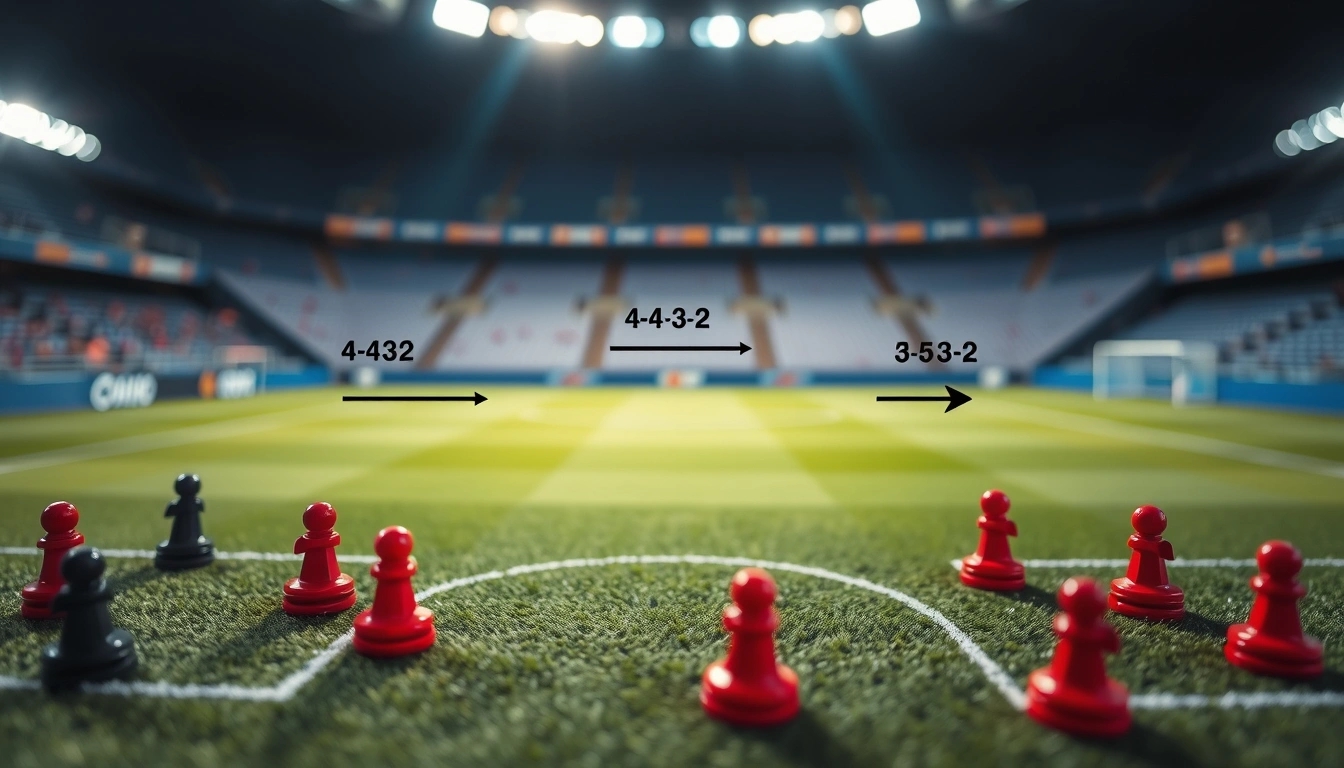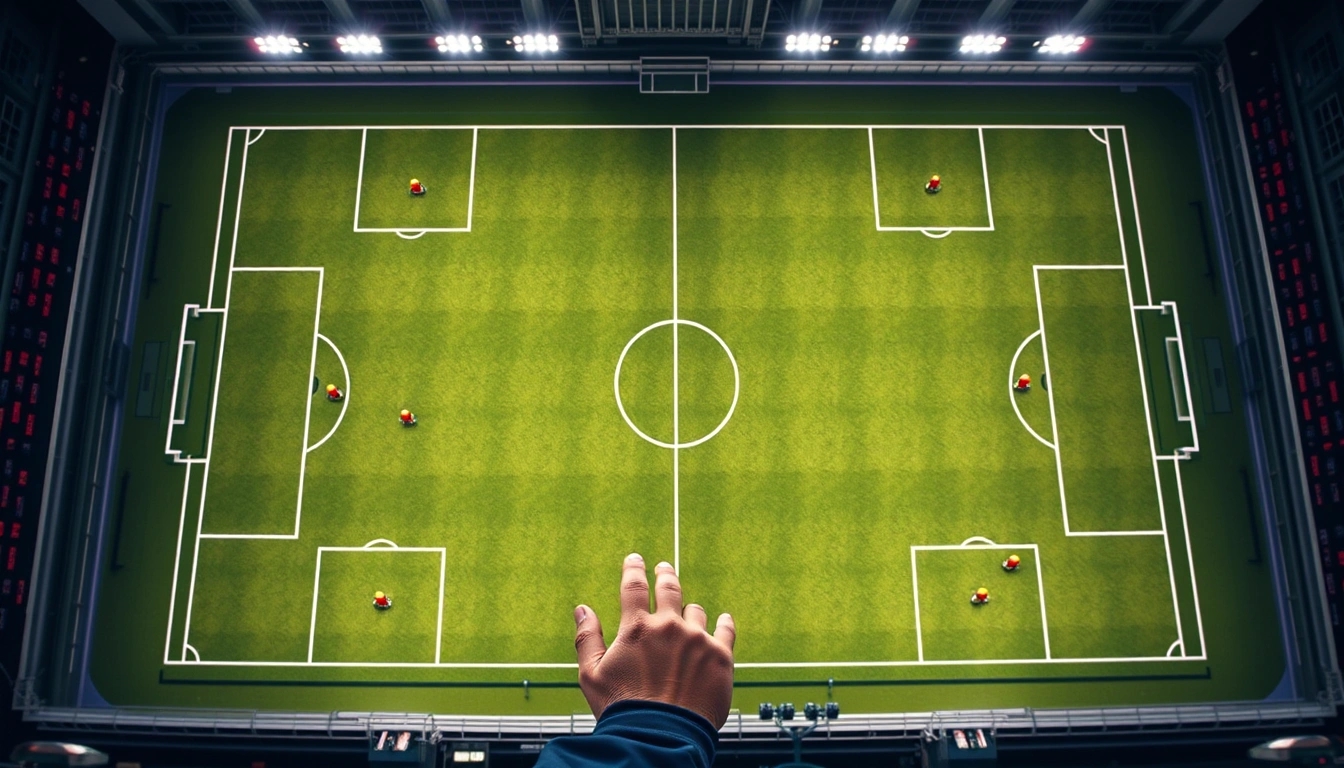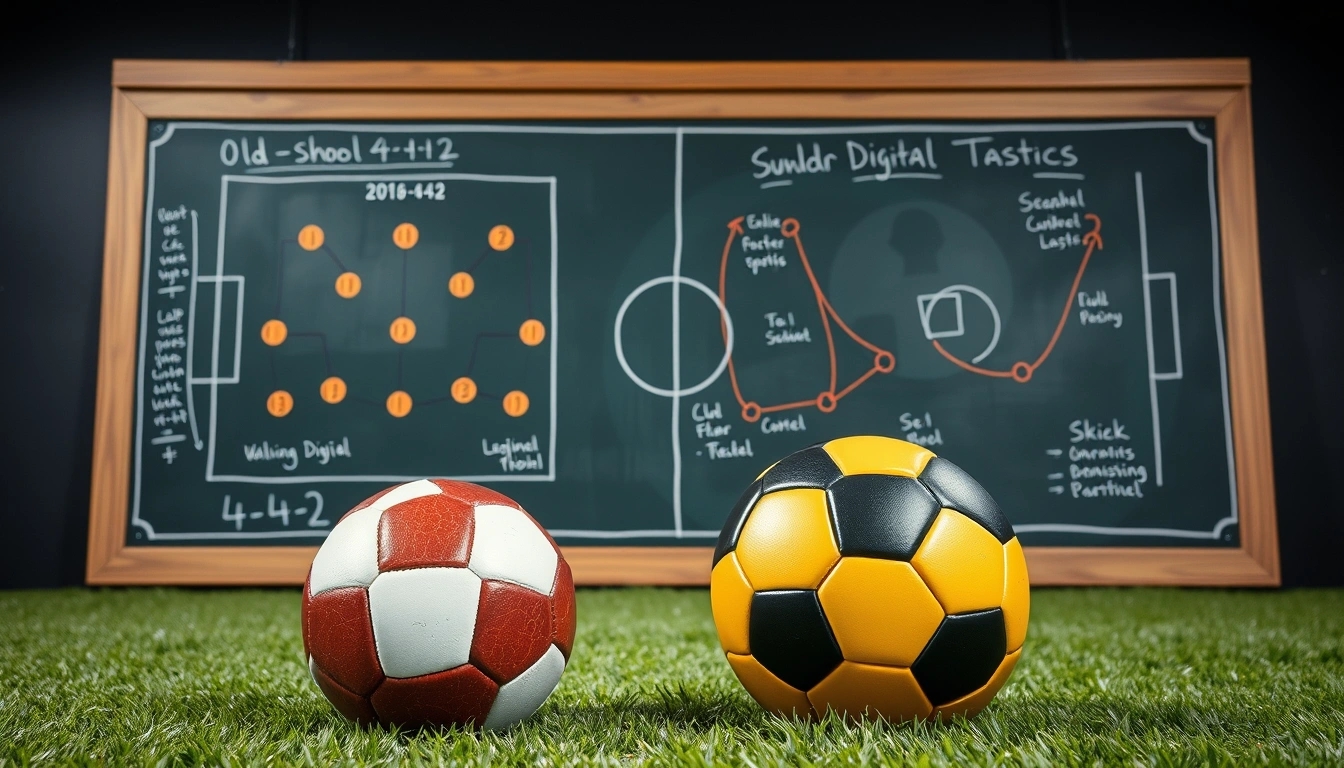The 4-4-2 formation – ah, the classic! For decades, it’s been the bread and butter of football tactics, a formation that screams balance and simplicity. But like your favorite vintage jeans, it’s had to adapt to keep up with the times. Let’s take a stroll down memory lane and then jump right into how the modern game has given this old favorite a fresh twist.
First off, the origins of 4-4-2 go way back to the mid-1900s when managers craved a setup that didn’t overcomplicate things. Four defenders, four midfielders, and two strikers – straightforward, easy to understand, and effective. It gave teams a solid defensive base while maintaining enough firepower upfront. It was like the Swiss Army knife of formations: reliable and versatile.
| Position | Traditional Role |
|---|---|
| Defenders (4) | Primarily focused on marking and clearing threats |
| Midfielders (4) | Balanced between defense and attack, wide players provided crosses |
| Strikers (2) | Main goal scorers, often working in tandem to exploit defenses |
Now, don’t get me wrong, the old-school 4-4-2 wasn’t perfect. Critics often pointed out how rigid it could be, especially against teams that played with fluid midfielders or three at the back. That’s why it gradually fell out of favor in the 21st century. Coaches started favoring formations like 4-3-3 or 3-5-2 which allowed more midfield dominance or wing-back creativity.
But here’s the kicker: the 4-4-2 isn’t dead. Nope, it’s just been through a makeover. Modern adaptations have seen managers tweak the roles within the formation. For example, the wide midfielders might now act more like wing-backs, bombing forward to support attacks while still tracking back. The two forwards might not just be poachers anymore but are asked to press high and create space.
- Modern 4-4-2 tweaks include:
- Inverted wingers who cut inside to shoot or create chances
- Midfielders swapping roles dynamically
- Higher defensive line with pressing from the front
It’s a formation that’s stubbornly sticking around because of its tactical flexibility. Need to shore up the defense? Pull the wide midfielders back. Want to attack like mad? Push them up and let the strikers run riot.
So, whether you’re a die-hard fan of the old-school “kick and rush” days or a modern tactician looking for a solid base with room for creativity, the 4-4-2 still has a place in football’s ever-evolving story. It’s like that reliable old mate who’s always ready to surprise you when you least expect it.
The Origins of 4-4-2
Let’s rewind the clock to the mid-1900s, when football tactics were a bit less complicated than today’s tactical spaghetti. The 4-4-2 formation wasn’t just a random choice; it was the bread and butter for a ton of teams across Europe and beyond. This setup quickly became the go-to strategy because it struck a neat balance between defense and attack — simple, effective, and easy to understand for players and coaches alike.
Back then, football wasn’t the ultra-fluid, position-swapping game we see nowadays. Coaches needed something reliable, a formation that gave structure without leaving gaps all over the pitch. Enter the 4-4-2: four defenders, four midfielders, and two strikers. That’s it. Nothing fancy, but boy, did it work.
- Defensive solidity: Four defenders lined up neatly, usually two center-backs and two full-backs, creating a solid wall that was tough to break down.
- Midfield balance: Four midfielders spread across the middle, often with two central midfielders holding the fort and two wide players providing width.
- Attacking duo: Two forwards up front, combining physical presence and goal-scoring instincts.
This formation gave teams a clear, organized shape — easy to teach and even easier to stick to during a match. It wasn’t flashy, but it was dependable. You could say it was the workhorse of football formations.
| Era | Key Features | Why It Worked |
|---|---|---|
| Mid-20th Century | 4 defenders, 4 midfielders, 2 strikers | Balance between defense and attack, simplicity |
| Post-War Football Boom | Emphasis on teamwork and discipline | Easy to implement, players knew their roles |
Now, don’t get me wrong, the 4-4-2 wasn’t perfect. As football evolved, so did tactics, and this formation started showing cracks — but back in its heyday? It was king. The beauty was in its predictability; opponents knew what to expect, but breaking down that solid structure was a nightmare.
Over time, coaches began to experiment, and the game moved towards more fluid systems. But the 4-4-2 laid the groundwork for modern formations, proving that sometimes, simplicity is the ultimate sophistication. It’s like your favorite pair of jeans — classic, reliable, never out of style. Well, almost never.
So, next time you see a team line up in 4-4-2, remember: you’re looking at a formation with deep roots, built on a foundation of balance, teamwork, and a bit of old-school charm.
Classic 4-4-2 Setup and Roles
The 4-4-2 formation is like that reliable old pair of boots — simple, sturdy, and effective when used right. At its core, it’s a straightforward setup: four defenders, four midfielders, and two strikers. Nothing fancy, just a classic balance between defense and attack that’s been the bread and butter for many teams over decades. But don’t be fooled by its simplicity; every player has a clear-cut job, and the magic happens when everyone sticks to their role.
Let’s break it down a bit. The back four defenders usually consist of two center-backs and two full-backs. The center-backs are the rock-solid pillars, tasked with stopping opposing strikers dead in their tracks. They’re not expected to roam too much — their job is to keep the defensive line tight and clear the ball out of danger. The full-backs, on the other hand, have a bit more freedom to push forward and support attacks, but their primary responsibility is still to track back quickly and shut down wingers.
- Center-backs: Defensive anchors, strong in tackles and aerial duels.
- Full-backs: Defensive duties first, but also overlapping runs to provide width.
Moving up the pitch, the midfield four usually line up flat across the middle. You’ve got two central midfielders who often share the workload — one might be a bit more defensive-minded, breaking up play and distributing the ball, while the other pushes forward to link up with the attack. The wide midfielders, or wingers, hug the touchlines, ready to whip in crosses or cut inside to create scoring chances. Their stamina is crucial because they’re expected to cover a lot of ground, helping out the full-backs defensively and then sprinting forward when the team goes on the attack.
| Position | Primary Responsibilities | Key Traits |
|---|---|---|
| Goalkeeper | Shot-stopping, organizing defense | Agility, communication |
| Center-backs | Defend central areas, aerial duels | Strength, positioning |
| Full-backs | Defend flanks, support attack | Speed, stamina |
| Central Midfielders | Ball distribution, defensive cover | Passing, vision |
| Wide Midfielders | Provide width, cross balls | Dribbling, pace |
| Strikers | Score goals, press defenders | Finishing, positioning |
Now, the forwards — the two strikers — are the spearhead of this formation. Traditionally, one striker plays as the target man, holding up the ball and bringing others into play, while the other is a bit quicker, darting in behind defenses to latch onto through balls. It’s a simple but effective partnership that keeps the opposition guessing. The beauty here is the balance: defense isn’t overloaded, midfielders aren’t stretched thin, and the attack has enough firepower to cause problems.
But here’s the catch: the 4-4-2 demands discipline. If the midfielders don’t track back, or if the full-backs get caught too far up, the whole structure crumbles. It’s a formation that rewards teamwork and work-rate over flashiness. Coaches loved it for its clarity — everyone knows their job, and there’s less confusion on the pitch.
In a nutshell, the traditional 4-4-2 is about straightforwardness. There’s no messing about with overly complex tactics or fluid positional changes. It’s defense and attack in neat boxes, and when executed well, it’s a formation that’s tough to break down and capable of quick, effective counterattacks. Old school? Absolutely. But sometimes, old school just works.

Why 4-4-2 Fell Out of Favor
The 4-4-2 formation, once the darling of football pitches worldwide, has seen its star dim over recent decades. Now, you might wonder why this seemingly balanced setup, with two banks of four and two strikers, lost its charm. Well, the answer isn’t as simple as “it just got old.” It’s a cocktail of tactical evolutions, player roles morphing, and the game itself speeding up to a new rhythm. Let’s unpack this.
| Factor | Explanation |
|---|---|
| Rise of Midfield Dominance | Modern teams crave more control in midfield, often packing three or even four players centrally. The 4-4-2’s flat midfield line struggles to compete against formations like 4-3-3 or 3-5-2, where numerical superiority in the middle can suffocate opponents. |
| Fluidity Over Rigidity | Football tactics have shifted towards fluid, interchangeable roles. The rigid lines of 4-4-2 limit this flexibility, making it harder for teams to adapt mid-game or exploit space dynamically. |
| Defensive Vulnerabilities | With only two central midfielders, teams often leave gaps between defense and midfield. Opponents can exploit these spaces, especially with quick counter-attacks or overlapping wing-backs. |
Now, don’t get me wrong — 4-4-2 isn’t dead. But it’s like that old pair of jeans you love, except now the fashion world demands skinny fits and stretch fabrics. The classic 4-4-2 just can’t keep up with the pace and tactical demands of today’s game. Coaches want formations that breathe, that morph as the match unfolds, and frankly, 4-4-2 can feel a bit too… predictable.
- Players’ Roles Are More Complex: Midfielders aren’t just holding or attacking; they’re expected to shuttle box-to-box, press relentlessly, and create overloads.
- Wing Play Has Changed: Traditional wide midfielders in 4-4-2 had fixed roles, but now wingers invert, cut inside, or drop deep, demanding more nuanced setups.
- Pressing Game: High pressing demands compactness and coordination that a flat 4-4-2 sometimes struggles to provide.
To put it bluntly, 4-4-2 often feels like trying to run a smartphone app on a flip phone. It just wasn’t designed for the multitasking, fast-switching demands of modern football. Coaches like Pep Guardiola and Jürgen Klopp have pushed the envelope with formations that emphasize midfield overloads, positional rotations, and pressing triggers — all areas where 4-4-2 can seem clunky.
Classic 4-4-2: - 4 Defenders- 4 Midfielders (flat line)- 2 StrikersModern Trends:- Midfield triangles or diamonds (3 or 4 midfielders)- Wing-backs replacing wide midfielders- Fluid front lines with false nines or inverted wingers
Still, some teams cling to the 4-4-2 for its simplicity and defensive solidity, especially in leagues where physicality rules the day. But if you’re looking to dominate possession or outsmart your opponent tactically, the 4-4-2 often feels like bringing a butter knife to a gunfight.
In the end, the decline of 4-4-2 boils down to the game evolving faster than the formation could adapt. It’s a classic case of “what worked yesterday doesn’t always cut it today.” The beautiful game demands creativity and flexibility, and while 4-4-2 laid the foundation for modern football, it now plays second fiddle to formations that embrace chaos and control in equal measure.
Modern Adaptations of 4-4-2
The 4-4-2 formation — once the bread and butter of football tactics — has undergone quite the makeover in recent years. Coaches didn’t just throw it out the window when football sped up; instead, they rolled up their sleeves and tweaked it to keep pace with the game’s lightning-fast tempo and unpredictable flow. But how exactly did they do it without losing the formation’s classic charm? Let’s dive into the nitty-gritty.
First off, the traditional 4-4-2 was all about balance — two banks of four, two strikers up top, straightforward and solid. But modern football isn’t so straightforward anymore. The game demands flexibility, quick transitions, and players who can think on their feet. So, coaches started to blur the lines between midfield and attack, turning those rigid lines into more fluid zones.
- Wingers Become Inverted or Inside Forwards: Instead of hugging the touchline, wingers in a modern 4-4-2 often cut inside, creating overloads in midfield or shooting opportunities. Think of them as midfielders disguised as forwards.
- Midfielders with Dual Roles: The central midfielders don’t just sit back and defend anymore. They’re expected to shuttle between defense and attack, often one playing a deep-lying playmaker role while the other pushes forward aggressively.
- Fullbacks Turn into Attackers: The traditional fullback role has evolved into wing-backs in some setups, providing width and pace down the flanks, stretching the opposition and creating space for midfield runners.
| Classic 4-4-2 Role | Modern Adaptation |
|---|---|
| Flat four midfield line | Diamond or staggered midfield for fluidity |
| Wingers stay wide | Wingers cut inside, creating attacking overloads |
| Two static strikers | One striker drops deep, the other presses high |
| Defensive fullbacks | Attacking wing-backs overlapping wingers |
Now, don’t get me wrong — these tweaks aren’t just for show. They’re practical responses to the modern game’s demands. Teams face opponents who press relentlessly and switch play in the blink of an eye. So, coaches have introduced more dynamic movements within the 4-4-2 framework to keep opponents guessing.
Take the example of pressing: modern 4-4-2s often see the two strikers coordinating a high press, forcing errors and quick turnovers. Meanwhile, midfielders drop back or surge forward depending on the phase of play. This constant ebb and flow make the formation look less like a rigid shape and more like a living organism.
- Pressing Triggers: Strikers initiating pressure on defenders.
- Midfield Rotation: Midfielders swapping positions to confuse marking assignments.
- Flexible Defensive Lines: The back four sometimes shifting into a back three during attacks.
One last thing — the mental aspect. Players in modern 4-4-2 systems need to be sharper, quicker to adapt, and more communicative. It’s no longer enough to just “stay in your zone.” The constant switching, overlapping runs, and pressing require brains as much as brawn.
So, while some purists might scoff at the idea of “messing” with the classic 4-4-2, the truth is these adaptations have breathed new life into it. It’s like giving an old car a turbo engine — same body, but way more oomph. And as football evolves, expect the 4-4-2 to keep surprising us, proving that sometimes, old school can still school the youngsters.
Key Players in 4-4-2 Systems
The 4-4-2 formation might seem like a blast from the past, but it’s still kicking around in the modern game, largely thanks to some players who just *get* it. You know, those folks who make the formation look less like a dusty old relic and more like a well-oiled machine? Yeah, those guys. The magic of 4-4-2 lies not just in the shape itself, but in how individual talents bring their own flair and grit to the system. It’s like a jazz band—everyone’s got their part, but the soloists make it sing.
Let’s start with the classic archetypes. The two strikers up front aren’t just goal-scoring machines; they complement each other. Think of the pairing as yin and yang—one might be a physical beast, bullying defenders and holding the ball up, while the other is a nimble finisher, darting into spaces and snapping up chances. Wayne Rooney and Didier Drogba back in the day? Perfect example. Rooney’s versatility and work rate paired with Drogba’s raw power made defenses sweat.
| Player | Role | Skill Highlight |
|---|---|---|
| Wayne Rooney | Second Striker / Attacking Midfielder | Vision, versatility, and tenacity |
| Didier Drogba | Target Man Striker | Strength, aerial dominance |
| Steven Gerrard | Central Midfielder | Box-to-box engine, long-range shooting |
| Gary Neville | Right Midfielder / Fullback | Defensive solidity, crossing |
| Harry Kane | Striker | Finishing, hold-up play |
| Bruno Fernandes | Attacking Midfielder | Creativity, passing |
Moving to the midfield, the 4-4-2 demands a blend of stamina, creativity, and defensive discipline. You can’t just have four midfielders wandering around like lost tourists. One of the central midfielders often acts as the engine room—breaking up play, distributing passes, and occasionally crashing the box. Steven Gerrard was a beast at this: a relentless runner with a knack for scoring screamers. Meanwhile, the wide midfielders have to be both wingers and wing-backs, providing width on offense and tracking back like their lives depend on it.
Now, fast forward to today, and you’ll find players like Harry Kane and Bruno Fernandes showing how modern stars can thrive in a 4-4-2. Kane isn’t just a poacher; he drops deep, links play, and drags defenders out of position. Fernandes, on the other hand, adds that creative spark, threading killer passes while still hustling defensively. They prove the old-school 4-4-2 can still be relevant if you tweak the roles a bit.
- Strikers: Must combine physicality with technical skill.
- Central Midfielders: The heartbeat of the team, balancing attack and defense.
- Wide Midfielders: Tireless runners who stretch the pitch and support both ends.
In short, the 4-4-2 isn’t just about plugging players into fixed spots. It’s about finding the right mix of personalities and skill sets. When the right players embrace their roles—whether it’s a hard-working midfielder like Gerrard or a clinical striker like Drogba—the formation clicks. It’s like a well-rehearsed dance, where every step counts.
So next time someone calls 4-4-2 “old-fashioned,” remind them it’s the players who bring it to life. Without their unique qualities, it’s just a shape on paper. But with the right cast? It’s a formation that’s still got plenty of fight left in it.

4-4-2 vs Other Popular Formations
Alright, let’s get down to brass tacks and pit the classic 4-4-2 formation against some of football’s more flashy cousins like the 4-3-3 and 3-5-2. It’s like comparing your reliable old sedan with a slick sports car and a rugged off-roader—each has its quirks, perks, and pitfalls depending on where you’re driving.
The 4-4-2, often dubbed the “old faithful” of formations, is all about balance. Two banks of four players create a neat defensive block with two strikers up front to pounce on chances. It’s straightforward, no-nonsense, and gives you solid defensive coverage while maintaining a decent attacking threat. But let’s be honest, it can sometimes feel a bit predictable and rigid, especially against teams that like to throw curveballs.
| Formation | Strengths | Weaknesses | Ideal Match Scenario |
|---|---|---|---|
| 4-4-2 | Balanced defense & attack, simple roles, strong wing play | Vulnerable to midfield overload, less fluid, predictable | Against teams with weak midfield, counter-attacking games |
| 4-3-3 | Midfield dominance, high pressing, wide attacking options | Can leave defense exposed, requires high stamina | Teams with strong midfielders, possession-based play |
| 3-5-2 | Midfield control, wing-back flexibility, solid central defense | Wing-backs can be overrun, complex for players to adapt | Against teams relying on wide play, needing midfield superiority |
Now, the 4-3-3 is like that flashy cousin who loves to hog the spotlight. It’s all about controlling the midfield with three central players, often allowing for a more fluid and dynamic attack. The wingers in a 4-3-3 are usually cutting inside or stretching the defense wide, which can really mess up a 4-4-2’s more rigid shape. But hey, this formation demands a lot of running and tactical awareness, and if your midfielders aren’t up to scratch, you could be left gasping for air and conceding goals.
- 4-4-2 thrives on simplicity and discipline.
- 4-3-3 offers creativity and midfield control.
- 3-5-2 provides flexibility but requires wing-backs who can run a marathon.
Speaking of the 3-5-2, this one is a bit of a tactical chameleon. With three center-backs and five midfielders (two of whom double as wing-backs), it’s designed to dominate the middle of the park and provide defensive solidity. The wing-backs are crucial here—they have to be both defenders and attackers, which is a tough ask. Against a 4-4-2, the 3-5-2 can exploit the flanks if those wing-backs are on fire, but if they get caught upfield, the defense might look like Swiss cheese.
Key Tactical Takeaways:- 4-4-2: + Solid defensive shape + Relies on wingers for width - Can be outnumbered in midfield- 4-3-3: + Midfield control & pressing + Versatile attack options - Requires fit, tactically aware players- 3-5-2: + Midfield dominance + Wing-back flexibility - Wing-backs’ stamina & positioning critical
So, which one wins? Well, it depends on your squad, your style, and the opponent. The 4-4-2 is great if you want a straightforward, disciplined setup that can frustrate teams and launch quick counters. The 4-3-3 is perfect for possession lovers who want to dominate the midfield and unleash creative attackers. The 3-5-2 is a bit of a wildcard, offering tactical flexibility but demanding a lot from wing-backs and midfielders.
At the end of the day, football’s beauty lies in its unpredictability—sometimes the old-school 4-4-2 stomps all over the fanciest setups, and sometimes the slick 4-3-3 or 3-5-2 leave it in the dust. Coaches who know their players and adapt on the fly tend to come out on top, no matter the formation.
Tactical Flexibility in 4-4-2
The 4-4-2 formation, a classic staple in football tactics, is often dismissed as rigid or old-fashioned, but that’s a bit unfair. What many fail to appreciate is just how adaptable this setup can be when the game is on the line. Coaches and players alike know that the 4-4-2 isn’t just a fixed shape; it’s a flexible framework that can be tweaked mid-game to either lock down the defense or ramp up the attack, depending on the situation.
Let’s start with defensive solidity. When a team needs to protect a lead or absorb pressure, the two banks of four can drop deeper and tighter. The midfielders, especially the wide players, tuck in closer to the center, turning the formation into something resembling a compact 4-5-1. This makes it harder for the opposition to find gaps between the lines. The two strikers don’t just disappear; one might drop back to act as an auxiliary midfielder, helping to congest the middle and disrupt passing lanes. This adjustment is crucial because it keeps the team balanced without sacrificing all attacking threat.
| Role | Typical Position | Adjusted Role |
|---|---|---|
| Wide Midfielders | Near touchline | Move inward to support central midfield |
| Strikers | Up front | One drops deeper to midfield |
| Fullbacks | Defensive line | Stay disciplined, rarely push forward |
Now, flip the coin and you get the attacking prowess tweak. When chasing a goal, the 4-4-2 can stretch out, with wide midfielders pushing higher and wider, almost becoming wingers in a 4-2-4 shape. The fullbacks join the attack, overlapping the wide midfielders to create overloads on the flanks. Midfielders get more license to make forward runs, and the strikers stay sharp, ready to exploit crosses or quick one-twos inside the box. This shift transforms the team into a more aggressive, forward-pushing unit.
- Wide Midfielders: Become attacking outlets, hugging the touchline and delivering crosses.
- Fullbacks: Push high to support the attack, often overlapping wide midfielders.
- Central Midfielders: Take on box-to-box roles, linking defense and attack.
- Strikers: Stay forward, pressing defenders and capitalizing on chances.
But, let’s be honest, this isn’t foolproof. Shifting gears mid-game demands a lot from players’ stamina and tactical awareness. If the team loses shape, it can get exposed, especially on counter-attacks. The beauty of 4-4-2 is its simplicity, but that simplicity can be a double-edged sword if players aren’t disciplined.
In essence, the 4-4-2 is like a Swiss Army knife — it might not be the flashiest tool in the box, but it’s reliable and can be adjusted to suit the moment’s needs. Whether you want to bunker down and defend a slender lead or throw caution to the wind and chase goals, the 4-4-2 has the versatility to handle it, as long as the team knows what it’s doing.
Common Mistakes Teams Make Using 4-4-2
The 4-4-2 formation, while beloved for its simplicity and balance, is far from a magic bullet. Many teams that try to implement it end up stumbling into some classic pitfalls, and honestly, it’s almost like watching a comedy of errors sometimes. Let’s break down the usual suspects that cause this formation to backfire spectacularly.
- Lack of Midfield Control: One of the biggest headaches with 4-4-2 is the midfield battle. With only four midfielders, it’s easy for opponents running a 4-3-3 or 4-2-3-1 to outnumber and outmaneuver you. This often leaves the central midfielders running ragged, trying to cover too much ground and eventually losing possession too often. It’s like trying to hold back a flood with a tea towel.
- Overreliance on Wide Midfielders: Traditional 4-4-2 depends heavily on wingers to provide width and crosses. But if those wide midfielders aren’t disciplined enough to track back or lack the stamina to run end-to-end, the team becomes vulnerable on the flanks. Opponents will exploit this by bombarding the fullbacks, leaving gaps that scream “score here!”
- Rigid Player Roles: The old-school 4-4-2 can sometimes be too rigid. Players sticking strictly to their zones without fluid movement can make the team predictable and easy to shut down. Modern football demands a bit more creativity and flexibility, and teams that cling to textbook roles often get left behind.
| Common Mistake | Impact | How to Fix It |
|---|---|---|
| Midfield Outnumbered | Loss of possession, reduced control | Deploy a more compact midfield or add a defensive midfielder |
| Flank Vulnerability | Exposed defense, increased crosses against | Wide midfielders track back diligently; fullbacks communicate well |
| Predictability | Easy to defend against, limited attacking options | Encourage fluid movement and interchange between players |
Now, let’s not forget the elephant in the room: the two-striker setup. It’s a double-edged sword. Sure, having two forwards can keep the opposition defense on their toes, but if those strikers don’t link up well or one is just a glorified spectator, the attack becomes disjointed. It’s like having two chefs in the kitchen who refuse to talk to each other—messy and inefficient.
Another often overlooked blunder is the defensive line’s positioning. In 4-4-2, the back four must stay tight and coordinated, but teams sometimes let their lines get stretched or lose concentration, inviting through balls and one-on-one situations with the keeper. It’s a rookie mistake that even professional teams fall for, and the result? Goals conceded from seemingly simple plays.
- Ignoring Transition Phases: The formation demands quick shifts from attack to defense and vice versa. If players aren’t drilled to transition smoothly, the team looks like a deer caught in headlights, vulnerable to fast breaks.
- Underestimating Opponent’s Adaptations: Modern teams rarely stick to one formation. If your 4-4-2 team can’t adjust on the fly, you’re in trouble. Stubbornly sticking to the plan when it’s clear it’s not working is a recipe for disaster.
In short, the 4-4-2 isn’t inherently flawed, but it requires smart, adaptable players and a coach who understands its limitations. Without that, it’s just a fancy way of setting your team up to get outplayed. So next time you see a team struggling with 4-4-2, don’t just blame the formation—look deeper at how it’s being executed (or butchered).

Future of 4-4-2 in Football
The 4-4-2 formation – a name that still rings bells in the minds of football purists and casual fans alike. But let’s be honest, the big question on everyone’s lips is: will this classic setup ever truly make a comeback, or is it destined to evolve (or maybe even disappear) in the relentless tactical arms race of modern football? Well, buckle up, because the answer isn’t as straightforward as you might think.
First off, the 4-4-2 isn’t exactly dead. It’s more like that old pair of boots you keep in the closet—worn, maybe a bit outdated, but still comfy and reliable when the occasion calls for it. Coaches today often glance back at this formation for its balance and simplicity. Two banks of four provide a neat defensive shape, while two strikers up front keep things spicy. But the game has changed, and so have the demands on players.
- Speed and fluidity: Modern football thrives on quick transitions and positional rotations, which sometimes clash with the rigidity of a traditional 4-4-2.
- Midfield dominance: Teams favor formations that pack the midfield to control possession, something the classic 4-4-2 struggles with.
Yet, don’t count it out just yet! Coaches are tinkering under the hood, blending 4-4-2 principles with contemporary tweaks. Think of it as 4-4-2 2.0.
| Traditional 4-4-2 | Modern Adaptations |
|---|---|
| Flat midfield line | Diamond or staggered midfield for better control |
| Two strikers upfront | One striker drops deep, second pushes wide or acts as a false nine |
| Wide midfielders hold position | Wingers invert or overlap to create overloads |
Now, here’s the kicker: some teams have managed to pull off a hybrid 4-4-2 that’s surprisingly effective, especially against opponents who underestimate it. It’s like that old trick in poker—you don’t always have to bluff big, sometimes a simple, steady hand wins the pot.
But, let’s get real. The 4-4-2’s future hinges on adaptability. If it stays stubbornly traditional, it risks becoming a relic, a nostalgic nod to simpler times. However, if coaches keep experimenting—mixing in pressing traps, flexible midfield roles, or even shifting into a 4-2-4 during attacks—it could carve out a niche in the tactical toolbox.
- Practical insight: Teams with disciplined defenders and hard-working midfielders can still leverage the 4-4-2 to frustrate possession-heavy opponents.
- Potential downside: Lack of midfield density can leave gaps, especially against teams that swarm the center.
In conclusion? The 4-4-2 isn’t going to dominate the headlines like it once did, but it’s far from extinct. It’s more like a vintage wine—best when aged with care and served in the right context. So, next time you see a team line up with two banks of four, don’t yawn just yet. There’s more brewing beneath that classic exterior than meets the eye.
Stay tuned, because football’s tactical landscape is a wild beast—always shifting, always surprising. And who knows? The 4-4-2 might just sneak back in when no one’s looking.
Frequently Asked Questions (The title must be written in English.)
- What is the main advantage of the 4-4-2 formation?
The 4-4-2 formation offers a perfect balance between defense and attack. It’s like having a well-oiled machine where every part knows its role, making it straightforward for players to understand their responsibilities. This classic setup provides solid defensive coverage with four defenders and a strong midfield presence, while still allowing two forwards to spearhead the attack.
- Why did the 4-4-2 formation lose popularity in modern football?
Modern football has evolved into a faster and more fluid game, demanding formations that adapt quickly to changing situations. The 4-4-2, while solid, can be rigid and sometimes leaves teams vulnerable against formations that flood the midfield. Coaches now prefer systems like 4-3-3 or 3-5-2 that offer more midfield control and flexibility, causing the classic 4-4-2 to fall out of favor.
- How have coaches adapted the 4-4-2 to fit modern tactics?
Coaches have cleverly tweaked the 4-4-2 by introducing variations such as the diamond midfield or shifting one midfielder into a more attacking role. These adaptations inject surprise and dynamism, allowing teams to maintain the formation’s structure while benefiting from increased creativity and pressing intensity. It’s like giving an old classic car a turbo boost for today’s race!
- Which players excel in a 4-4-2 system?
Players who thrive in the 4-4-2 are often versatile, disciplined, and possess great stamina. Iconic strikers who can work in tandem, solid midfielders who can both defend and attack, and full-backs who support wing play are crucial. Think of legends like Alan Shearer or modern pros who seamlessly blend teamwork with individual flair.
- How does 4-4-2 compare to other popular formations like 4-3-3?
While 4-4-2 is balanced and straightforward, 4-3-3 offers more attacking width and midfield dominance. The 4-4-2 can sometimes be outnumbered in midfield, but it compensates with defensive solidity and clear roles. Choosing between them depends on the team’s style and the opponent’s tactics — it’s a chess game on grass!
- Can the 4-4-2 formation be flexible during a match?
Absolutely! One of the 4-4-2’s hidden strengths is its tactical flexibility. Coaches can shift midfielders to defensive or attacking roles mid-game, or adjust the forwards’ positioning to press high or hold back. This adaptability allows teams to respond quickly to evolving match situations without abandoning their core structure.
- What are common mistakes teams make when using the 4-4-2?
Teams often falter by not maintaining midfield discipline, leaving gaps that opponents exploit. Another mistake is poor communication between the two forwards, which can stifle attacking chances. Also, neglecting the full-backs’ roles in supporting the wings can reduce the formation’s effectiveness. It’s like missing a gear in a finely tuned engine.
- Is there a future for the 4-4-2 in modern football?
Despite its ups and downs, the 4-4-2 isn’t going anywhere. Its simplicity and balance make it a reliable fallback. With ongoing tactical innovations, we might see new versions of 4-4-2 that surprise us all. Think of it as a classic tune remixed for today’s dance floor — timeless but refreshed.












